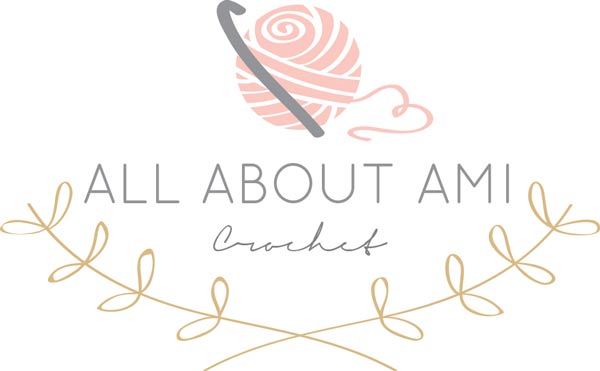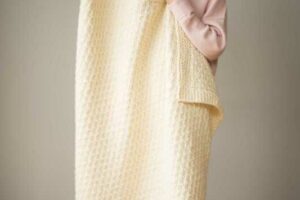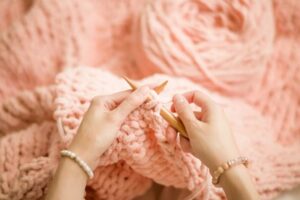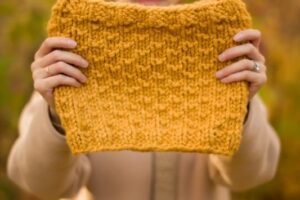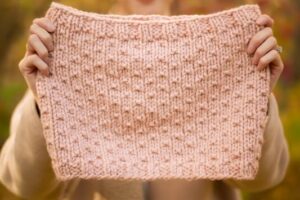***You can purchase an AD-FREE PDF of this pattern on Etsy HERE! This beautifully formatted PDF includes the step-by-step pictures and is a total of 10 pages including the cover page! It is important that you follow along with my STEP-BY-STEP BLOG POST HERE to see more detailed photos and the step-by-step making of this cardigan! You can also find this pattern in my Easy & Modern Knits Pattern Bundle found HERE (includes 30 of my knit patterns at a discounted price)! The Lion Brand Yarn kit HERE includes the pattern and all the gorgeous Truboo yarn needed to make this cape!
The stunning Dawn Cape is a statement piece with its beautiful ridged texture and gorgeous drape! This oversized cape features tapered shoulders and a delicate ribbed collar and ribbed arm openings with subtle ruching. You will love working with soft Truboo yarn that is silky to the touch with a lovely sheen. The Dawn Cape is the perfect layering piece over all your outfits!
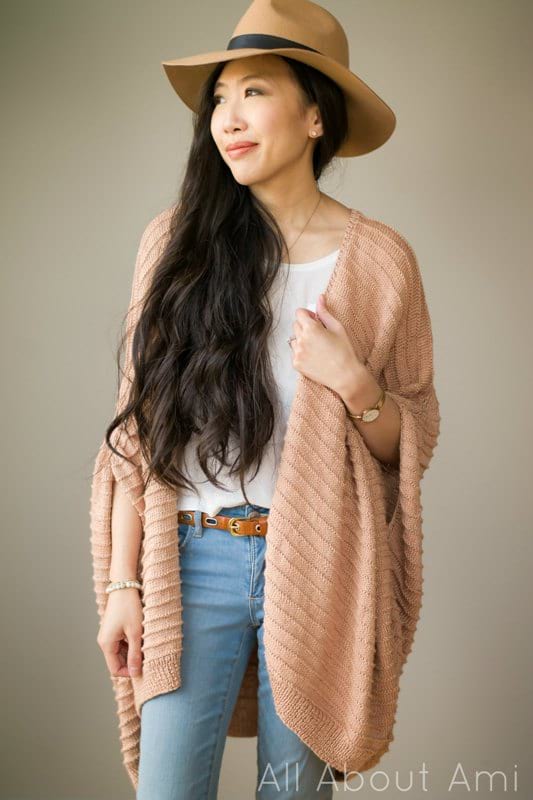
Materials:
- Truboo Yarn– level 3 DK lightweight yarn (see below for yardage) – 100% rayon from bamboo; I used the colour “Tan” – purchase the convenient KIT HERE that contains all the yarn you need!
- Clover Takumi 29″ 4 mm circular needles for panels; 48″ cord for picking up stitches along collar
- Yarn needle
- Lock ring stitch markers
Gauge: 24 sts and 32 rows = 4” in garter ridge + stockinette pattern
Final Measurements (in inches):

Approximate Yardage/Number of Skeins Required:
Extra Small/Small: 8 skeins, ~790 g/1910 yards
Medium/Large: 9 skeins, ~880 g/2120 yards
XL/2XL: 10 skeins, ~970 g/2340yards
3X/4X: 11 skeins, ~1060 g/2550 yards
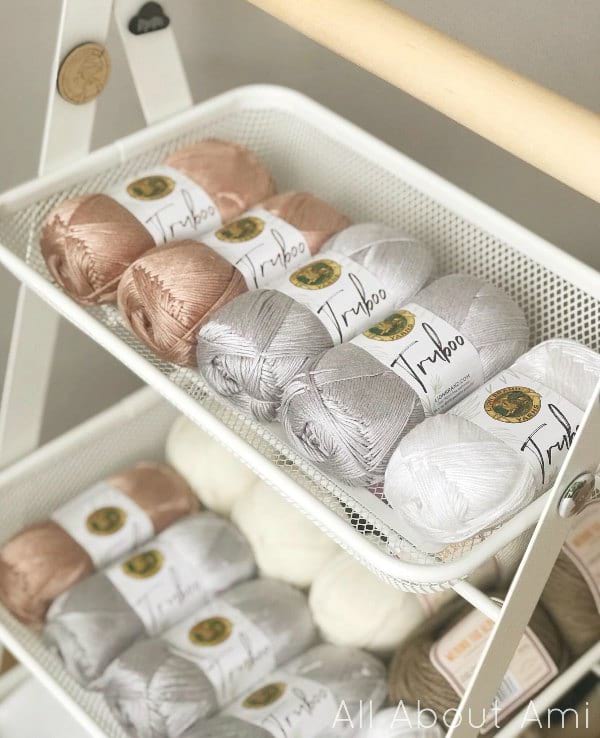
Notes:
- One back panel and two fronts panels are knitted using mostly stockinette stitch rows with intermittent garter stitch rows to create “garter ridges”.
- To help divide up the pattern, each garter ridge and stockinette portion is referred to as a “chunk” (e.g. Chunk #1, Chunk #2, etc) and is comprised of 6 rows.
- The front and back panels are worked from the bottom up starting with the ribbing. They are shaped with decreases along the sides towards the top to provide some shaping for the shoulders/arm openings. The decreases are stacked closely together to provide a ruched/cinched effect.
- The front and back panels are seamed together using the whip stitch at the top (shoulders) and the vertical invisible seaming technique along the sides, leaving a hole for the arm openings.
- Stitches are picked up along the collar and a delicate ribbing is worked. Stitches are picked up along the arm opening and a delicate ribbing is worked.
Sizing Notes:
- This cape is oversized, relaxed, loose and slouchy. Keep in mind that the Truboo will stretch with repeated wear and gravity as well. 4 sizes are provided in this pattern with each size differing by 4” in the back panel.
- I am 5’6 and wearing the size M/L for reference.
- If you would like the cape to be smaller, decrease the number of stitches you cast on for the front and back panels (you can adjust by any number since the shoulder shaping decreases are worked towards either the end or beginning of the rows and is unaffected by the cast on number). If you would like the cape to be wider, increase the number of stitches you cast on for the front and back panels. Keep in mind that the design is quite oversized, so if you would like a more fitted look, you can make your back panel a lot smaller using the gauge as a reference.
- If you would like the cape to be longer, increase the number of rows for the back and front panels. If you would like the cape to be shorter, decrease the number of rows for the back and front panels. When adjusting the number of rows for the length, keep in mind that each chunk is comprised of 6 rows, so try adding or decreasing by number of chunks (e.g. add or take away 2 chunks, or 12 rows from the beginning chunk section [Chunks 1-28] before the shoulder decreases). The length is the same for all the sizes, but you can adjust your length based on your height and where you want the cape to fall (you can measure a favourite sweater or cardigan in your closet if you want a length reference). The decreases are worked over 46 rows (23 decrease rows with knit or purl rows in between) or 5.75”, so keep that in mind when choosing your length and how many chunks you want to include (e.g. if you want your final length to be 25”, work the pattern until you have reached 19.25” (25” – 5.75”) and then begin the decrease portion.
- This pattern is written for the following sizes (I would recommend highlighting or circling the numbers for your size throughout the pattern): XS/S, M/L, XL/2X, 3X/4X.
Decrease Row Notes:
- For the left front panel (when you are looking at the cape), we want to use the K2tog decrease since it is right leaning. The decreases will be worked towards the end of the row. This is the DECREASE ROW for the left front panel: {Knit across until 7 stitches remain. *K2tog* x 3, knit last stitch.} Each decrease row reduces the stitch count by 3 stitches.
- For the right front panel, we want to use the SSK (slip slip knit) decrease since it is left leaning. The decreases will be worked towards the beginning of the row. This is the DECREASE ROW for the right front panel: {Knit first stitch, *SSK* x 3. Knit rest of stitches.} Each decrease row reduces the stitch count by 3 stitches.
- For the back panel, we will be using BOTH types of decreases (K2tog and SSK) on either end to mirror the decreases of the front panels. This is the DECREASE ROW for the back panel: {Knit first stitch, *SSK* x 3. Knit across till 7 stitches remain. *K2tog* x 3, knit last stitch). Each decrease row reduces the stitch count by 6 stitches.
- All the decrease rows are always worked on the knit rows/right side of the project (i.e. never the purl rows). Each front panel and back panel has 23 decrease rows in total.
- If desired, you can place a stitch marker on the back and front panels to help you visualize how many stitches you will be decreasing (e.g. you will be decreasing 69 stitches for the front panel since 23 decrease rows times 3 stitches per decrease row = 69 sts).
- K2tog (knit 2 stitches together): To knit 2 stitches together, insert the right needle into two stitches at the same time and knit. This will result in a decrease of one stitch. This decrease slants to the right. See a video demonstration of K2tog HERE!
- SSK (slip, slip, knit these 2 stitches together): Slip the first stitch as if to knit, then slip the next stitch as if to knit. Insert the left needle into the front of both slipped stitches and knit them together. This decrease slants to the left. See a video demonstration of SSK HERE!
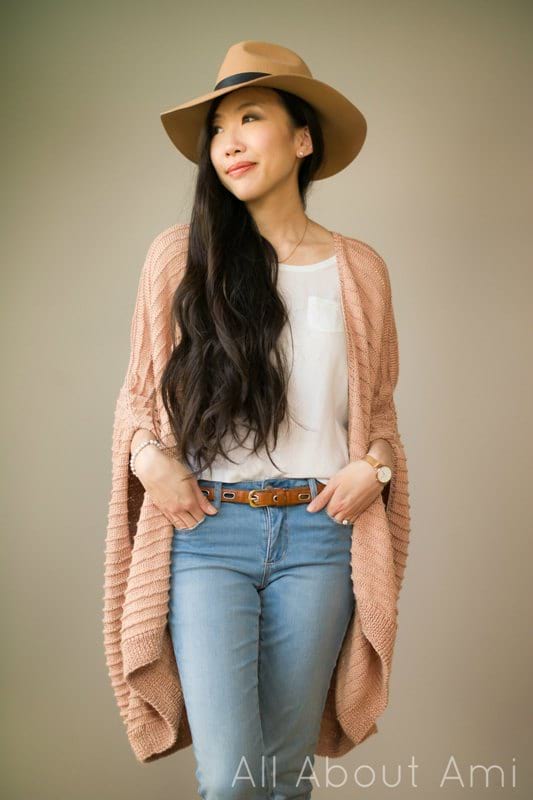
*Please reference my detailed step-by-step blog post HERE to see pictures of the back and front panels, decreases, collar ribbing and sleeve ribbing.
PATTERN:
- Back Panel
We will begin with the ribbing.
Using 4 mm needles,
Cast on 236 (260, 284, 308) stitches using long tail cast-on.
Row 1: *Knit 1, Purl 1* across. (236, 260, 284, 308)
Row 2 – 15: Repeat Row 1. (236, 260, 284, 308)
Ribbing is now complete! We will now begin the garter ridges and stockinette portion that forms the rest of the panel. Start off with the garter ridge:
R16: Knit all stitches. (236, 260, 284, 308)
R17: Knit all stitches. (236, 260, 284, 308)
Now move into the stockinette portion:
R18: Knit all stitches. (236, 260, 284, 308)
R19: Purl all stitches. (236, 260, 284, 308)
R20: Knit all stitches. (236, 260, 284, 308)
R21: Purl all stitches. (236, 260, 284, 308)
One garter ridge & stockinette portion has been completed comprised of 6 rows (Chunk #1). Continue repeating this pattern until it is time to work the decreases (you can work fewer chunks if you want your panels to be shorter):
R22-27: Repeat R16-21 to form Chunk #2.
R28-33: Repeat R16-21 to form Chunk #3.
R34-39: Repeat R16-21 to form Chunk #4.
R40-45: Repeat R16-21 to form Chunk #5.
R46-51: Repeat R16-21 to form Chunk #6.
R52-57: Repeat R16-21 to form Chunk #7.
R58-63: Repeat R16-21 to form Chunk #8.
R64-69: Repeat R16-21 to form Chunk #9.
R70-75: Repeat R16-21 to form Chunk #10.
R76-81: Repeat R16-21 to form Chunk #11.
R82-87: Repeat R16-21 to form Chunk #12.
R88-93: Repeat R16-21 to form Chunk #13.
R94-99: Repeat R16-21 to form Chunk #14.
R100-105: Repeat R16-21 to form Chunk #15.
R106-111: Repeat R16-21 to form Chunk #16.
R112-117: Repeat R16-21 to form Chunk #17.
R118-123: Repeat R16-21 to form Chunk #18.
R124-129: Repeat R16-21 to form Chunk #19.
R130-135: Repeat R16-21 to form Chunk #20.
R136-141: Repeat R16-21 to form Chunk #21.
R142-147: Repeat R16-21 to form Chunk #22.
R148-153: Repeat R16-21 to form Chunk #23.
R154-159: Repeat R16-21 to form Chunk #24.
R160-165: Repeat R16-21 to form Chunk #25.
R166-171: Repeat R16-21 to form Chunk #26.
R172-177: Repeat R16-21 to form Chunk #27.
R178-183: Repeat R16-21 to form Chunk #28.
We will now begin the next Chunk (Chunk #29) which is comprised of one garter ridge and the beginning of the decrease rows. Here is the garter ridge:
R184: Knit all stitches. (236, 260, 284, 308)
R185: Knit all stitches. (236, 260, 284, 308)
Garter ridge has been worked – now it is time to begin the decrease rows (each decrease row decreases the stitch count by 6 sts):
R186: WORK DECREASE ROW. (230, 254, 278, 302)
R187: Purl all stitches. (230, 254, 278, 302)
R188: WORK DECREASE ROW. (224, 248, 272, 296)
R189: Purl all stitches. (224, 248, 272, 296)
Let’s begin the next chunk. From here on in, you will work a decrease row for every right side row (even number) while continuing the garter ridge/stockinette portion pattern to create chunks.
Chunk #30:
R190: WORK DECREASE ROW. (218, 242, 266, 290)
R191: Knit all stitches. (218, 242, 266, 290)
R192: WORK DECREASE ROW. (212, 236, 260, 284)
R193: Purl all stitches. (212, 236, 260, 284)
R194: WORK DECREASE ROW. (206, 230, 254, 278)
R195: Purl all stitches. (206, 230, 254, 278)
Chunk #31:
R196: WORK DECREASE ROW. (200, 224, 248, 272)
R197: Knit all stitches. (200, 224, 248, 272)
R198: WORK DECREASE ROW. (194, 218, 242, 266)
R199: Purl all stitches. (194, 218, 242, 266)
R200: WORK DECREASE ROW. (188, 212, 236, 260)
R201: Purl all stitches. (188, 212, 236, 260)
Chunk #32:
R202: WORK DECREASE ROW. (182, 206, 230, 254)
R203: Knit all stitches. (182, 206, 230, 254)
R204: WORK DECREASE ROW. (176, 200, 224, 248)
R205: Purl all stitches. (176, 200, 224, 248)
R206: WORK DECREASE ROW. (170, 194, 218, 242)
R207: Purl all stitches. (170, 194, 218, 242)
Chunk #33:
R208: WORK DECREASE ROW. (164, 188, 212, 236)
R209: Knit all stitches. (164, 188, 212, 236)
R210: WORK DECREASE ROW. (158, 182, 206, 230)
R211: Purl all stitches. (158, 182, 206, 230)
R212: WORK DECREASE ROW. (152, 176, 200, 224)
R213: Purl all stitches. (152, 176, 200, 224)
Chunk #34:
R214: WORK DECREASE ROW. (146, 170, 194, 218)
R215: Knit all stitches. (146, 170, 194, 218)
R216: WORK DECREASE ROW. (140, 164, 188, 212)
R217: Purl all stitches. (140, 164, 188, 212)
R218: WORK DECREASE ROW. (134, 158, 182, 206)
R219: Purl all stitches. (134, 158, 182, 206)
Chunk #35:
R220: WORK DECREASE ROW. (128, 152, 176, 200)
R221: Knit all stitches. (128, 152, 176, 200)
R222: WORK DECREASE ROW. (122, 146, 170, 194)
R223: Purl all stitches. (122, 146, 170, 194)
R224: WORK DECREASE ROW. (116, 140, 164, 188)
R225: Purl all stitches. (116, 140, 164, 188)
Chunk #36:
R226: WORK DECREASE ROW. (110, 134, 158, 182)
R227: Knit all stitches. (110, 134, 158, 182)
R228: WORK DECREASE ROW. (104, 128, 152, 176)
R229: Purl all stitches. (104, 128, 152, 176)
R230: WORK DECREASE ROW. (98, 122, 146, 170)
Cast off all stitches purlwise.
- Left and Right Front Panels
We will begin with the ribbing.
Using 4 mm needles,
Cast on 108 (120, 132, 144) stitches using long tail cast-on.
Row 1: *Knit 1, Purl 1* across. (108, 120, 132, 144)
Row 2 – 15: Repeat Row 1. (108, 120, 132, 144)
Ribbing is now complete! We will now begin the garter ridges and stockinette portion that forms the rest of the panel. Start off with the garter ridge:
R16: Knit all stitches. (108, 120, 132, 144)
R17: Knit all stitches. (108, 120, 132, 144)
Now move into the stockinette portion:
R18: Knit all stitches. (108, 120, 132, 144)
R19: Purl all stitches. (108, 120, 132, 144)
R20: Knit all stitches. (108, 120, 132, 144)
R21: Purl all stitches. (108, 120, 132, 144)
One garter ridge & stockinette portion has been completed comprised of 6 rows (Chunk #1). Continue repeating this pattern until it is time to work the decreases (you can work fewer chunks if you want your panels to be shorter):
R22-27: Repeat R16-21 to form Chunk #2.
R28-33: Repeat R16-21 to form Chunk #3.
R34-39: Repeat R16-21 to form Chunk #4.
R40-45: Repeat R16-21 to form Chunk #5.
R46-51: Repeat R16-21 to form Chunk #6.
R52-57: Repeat R16-21 to form Chunk #7.
R58-63: Repeat R16-21 to form Chunk #8.
R64-69: Repeat R16-21 to form Chunk #9.
R70-75: Repeat R16-21 to form Chunk #10.
R76-81: Repeat R16-21 to form Chunk #11.
R82-87: Repeat R16-21 to form Chunk #12.
R88-93: Repeat R16-21 to form Chunk #13.
R94-99: Repeat R16-21 to form Chunk #14.
R100-105: Repeat R16-21 to form Chunk #15.
R106-111: Repeat R16-21 to form Chunk #16.
R112-117: Repeat R16-21 to form Chunk #17.
R118-123: Repeat R16-21 to form Chunk #18.
R124-129: Repeat R16-21 to form Chunk #19.
R130-135: Repeat R16-21 to form Chunk #20.
R136-141: Repeat R16-21 to form Chunk #21.
R142-147: Repeat R16-21 to form Chunk #22.
R148-153: Repeat R16-21 to form Chunk #23.
R154-159: Repeat R16-21 to form Chunk #24.
R160-165: Repeat R16-21 to form Chunk #25.
R166-171: Repeat R16-21 to form Chunk #26.
R172-177: Repeat R16-21 to form Chunk #27.
R178-183: Repeat R16-21 to form Chunk #28.
We will now begin the next Chunk (Chunk #29) which is comprised of one garter ridge and the beginning of the decrease rows. Here is the garter ridge:
R184: Knit all stitches. (108, 120, 132, 144)
R185: Knit all stitches. (108, 120, 132, 144)
Garter ridge has been worked – now it is time to begin the decrease rows. Please note the differences in the decrease rows before the Left and Right front panels as they use different decrease stitches (each decrease row reduces the stitch count by 3 stitches):
R186: WORK DECREASE ROW. (105, 117, 129, 141)
R187: Purl all stitches. (105, 117, 129, 141)
R188: WORK DECREASE ROW. (102, 114, 126, 138)
R189: Purl all stitches. (102, 114, 126, 138)
Let’s begin the next chunk. From here on in, you will work a decrease row for every right side row (even number) while continuing the garter ridge/stockinette portion pattern to create chunks.
Chunk #30:
R190: WORK DECREASE ROW. (99, 111, 123, 135)
R191: Knit all stitches. (99, 111, 123, 135)
R192: WORK DECREASE ROW. (96, 108, 120, 132)
R193: Purl all stitches. (96, 108, 120, 132)
R194: WORK DECREASE ROW. (93, 105, 117, 129)
R195: Purl all stitches. (93, 105, 117, 129)
Chunk #31:
R196: WORK DECREASE ROW. (90, 102, 114, 126)
R197: Knit all stitches. (90, 102, 114, 126)
R198: WORK DECREASE ROW. (87, 99, 111, 123)
R199: Purl all stitches. (87, 99, 111, 123)
R200: WORK DECREASE ROW. (84, 96, 108, 120)
R201: Purl all stitches. (84, 96, 108, 120)
Chunk #32:
R202: WORK DECREASE ROW. (81, 93, 105, 117)
R203: Knit all stitches. (81, 93, 105, 117)
R204: WORK DECREASE ROW. (78, 90, 102, 114)
R205: Purl all stitches. (78, 90, 102, 114)
R206: WORK DECREASE ROW. (75, 87, 99, 111)
R207: Purl all stitches. (75, 87, 99, 111)
Chunk #33:
R208: WORK DECREASE ROW. (72, 84, 96, 108)
R209: Knit all stitches. (72, 84, 96, 108)
R210: WORK DECREASE ROW. (69, 81, 93, 105)
R211: Purl all stitches. (69, 81, 93, 105)
R212: WORK DECREASE ROW. (66, 78, 90, 102)
R213: Purl all stitches. (66, 78, 90, 102)
Chunk #34:
R214: WORK DECREASE ROW. (63, 75, 87, 99)
R215: Knit all stitches. (63, 75, 87, 99)
R216: WORK DECREASE ROW. (60, 72, 84, 96)
R217: Purl all stitches. (60, 72, 84, 96)
R218: WORK DECREASE ROW. (57, 69, 81, 93)
R219: Purl all stitches. (57, 69, 81, 93)
Chunk #35:
R220: WORK DECREASE ROW. (54, 66, 78, 90)
R221: Knit all stitches. (54, 66, 78, 90)
R222: WORK DECREASE ROW. (51, 63, 75, 87)
R223: Purl all stitches. (51, 63, 75, 87)
R224: WORK DECREASE ROW. (48, 60, 72, 84)
R225: Purl all stitches. (48, 60, 72, 84)
Chunk #36:
R226: WORK DECREASE ROW. (45, 57, 69, 81)
R227: Knit all stitches. (45, 57, 69, 81)
R228: WORK DECREASE ROW. (42, 54, 66, 78)
R229: Purl all stitches. (42, 54, 66, 78)
R230: WORK DECREASE ROW. (39, 51, 63, 75)
Cast off all stitches purlwise.
- Assembly:
Place the front panels onto the back panel, ensuring that the decreases line up accordingly (there should be a 20 stitch gap in the middle of the back panel). Use stitch markers to help hold the pieces in place if desired. Whip stitch tops of front panels to back panel (go through both front and back loops of flat section at top, and line up the garter ridges for the slanted decrease section to make it easier to attach). Whenever using the whip stitch, seam the wrong sides together so that the seam is less visible on the right side. Use the vertical invisible seaming technique to attach sides of front panels to back panel, making sure to leave an arm hole of your desired size (I left a 10” gap). Use the garter ridges as a reference point when seaming the panels together to ensure they are lining up correctly.
- Collar Ribbing:
Using 4 mm needles,
Starting in bottom left corner, pick up 3 out of every 4 stitches along the front panel, across the back panel, and down the other front panel. Pick up an even number of stitches or adjust the pattern below accordingly to build up ribbing pattern.
To pick up stitches using working yarn, insert your needle into the first stitch along the edge. Yarn over, then pull up a loop. Keep inserting your needle into the next stitch, yarning over, and pulling up a loop.
Row 1: *K1, P1* across.
R2-5: Repeat Row 1. Cast off in ribbing and weave in ends.
- Arm Opening Edging:
Using 4 mm needles,
Starting in bottom of arm hole, pick up 3 out of every 4 stitches around the arm hole working clockwise (half the stitches will be along the back panel and half will be along the front panel). Pick up an even number of stitches or adjust the pattern below accordingly to build up ribbing pattern.
To pick up stitches using working yarn, insert your needle into the first stitch along the edge. Yarn over, then pull up a loop. Keep inserting your needle into the next stitch, yarning over, and pulling up a loop.
Row 1: *K1, P1* across.
R2-3: Repeat Row 1.
Cast off in ribbing and weave in ends.
*******************************************
I adore my beautiful Dawn Cape and how it feels and hangs against my body! The silhouette and shape of this cape are so stylish as the cape glides past my shoulders with its sleek arm openings.
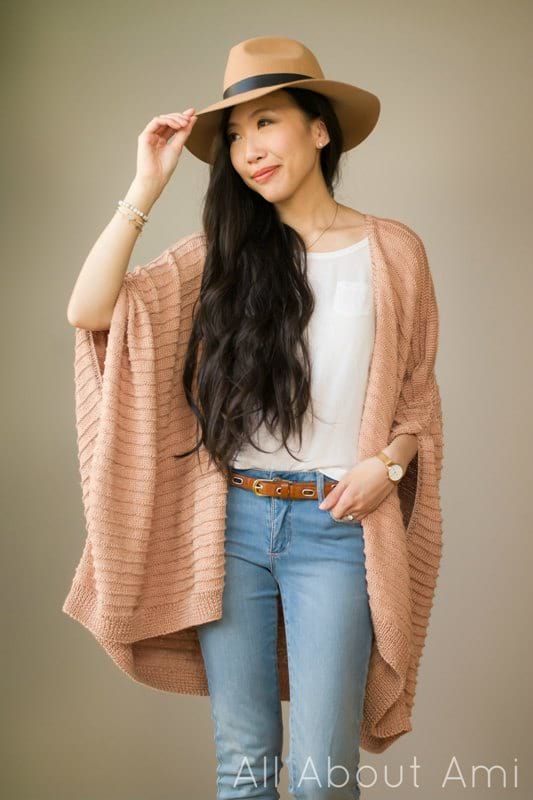
I am very proud of the ruching detail and decreases along the shoulders and arm openings! I think it adds such a unique touch to this Dawn Cape!
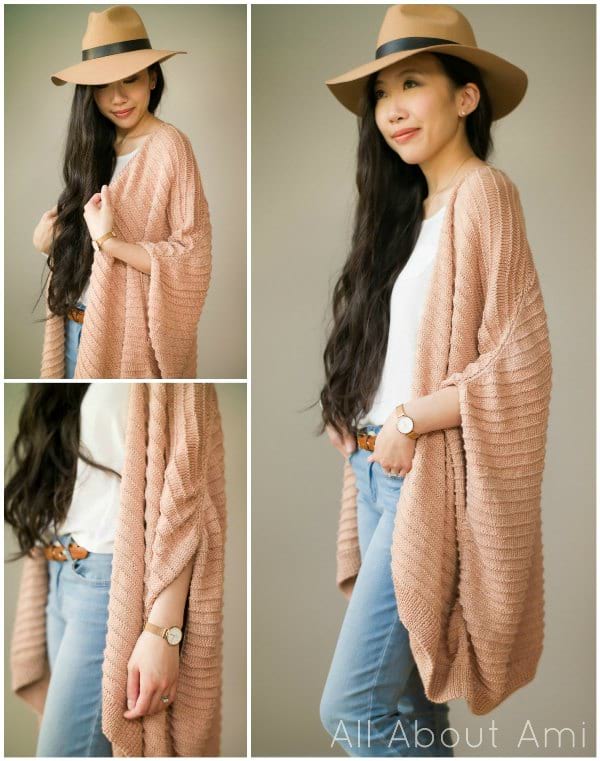
Look how gorgeous the back looks! I imagine myself wearing this cape layered over many different outfits, from jeans and a tee to rompers and dresses. If you have been wanting to try the new Truboo yarn, this cape is a great way to work with it – check out the Lion Brand Yarn kit HERE!
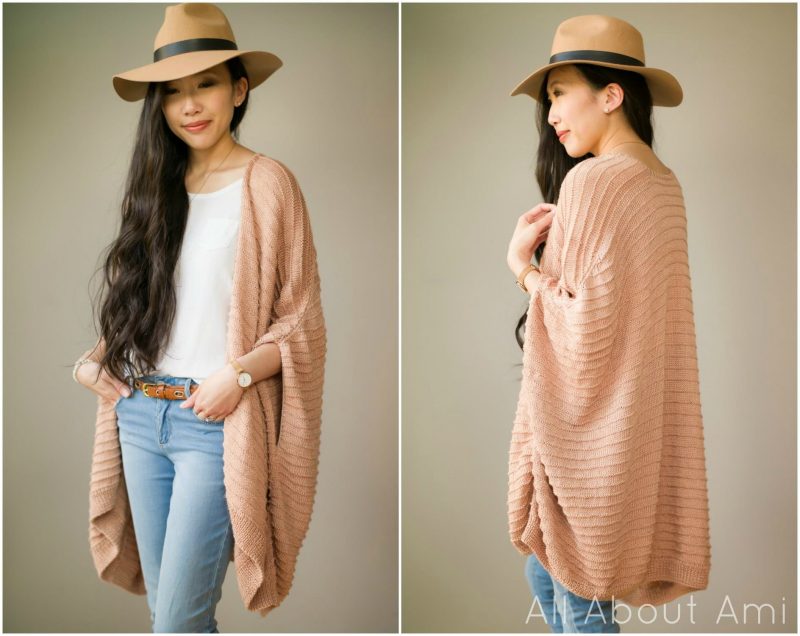
I hope you love the Dawn Cape and I cannot wait to see your projects – the crochet version will be coming next month! Happy knitting, everyone!
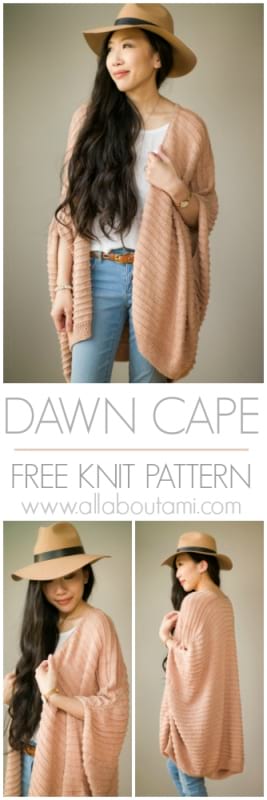
{This post is sponsored by Lion Brand Yarn! I’ve loved working with their yarn throughout the years and I’m thrilled that I get to collaborate with them every month!}
This pattern is an original pattern by Stephanie Lau of All About Ami. Please do not claim this pattern as your own. If you wish to share this pattern, you may link to this pattern but please do not reprint it on your site. You may keep a copy for your own personal use but please DO NOT sell the pattern or distribute it.
You may sell products made from this pattern but please clearly credit the design to me, Stephanie Lau of All About Ami, and provide a link to my blog www.AllAboutAmi.com. Permission is NOT granted for mass production or factory manufacturing of any kind. Thank you for being respectful and for your understanding!
